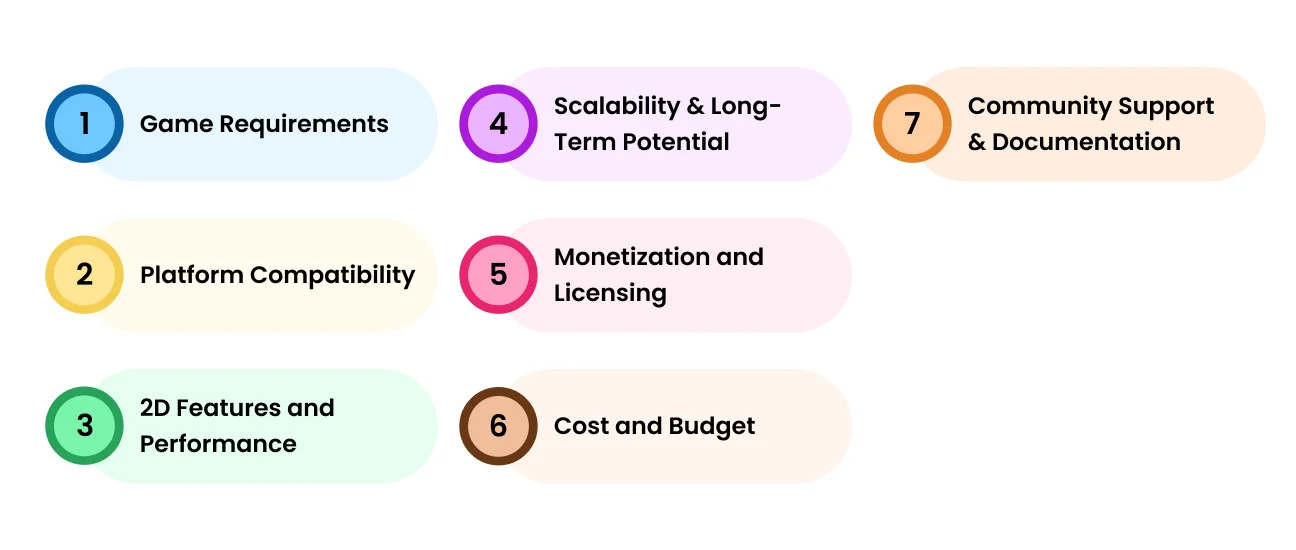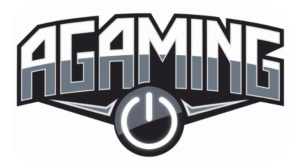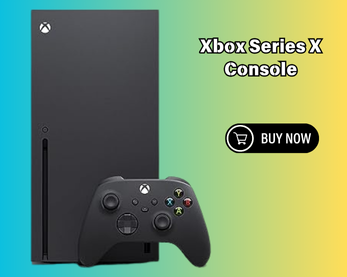Choosing the best 2D game engine comes down to matching your project’s needs with the right tool’s capabilities. Factors like performance, platform compatibility, scalability, ease of use, and cost all play a role in the decision. Whether you prioritize creative freedom, rapid development, or long-term growth, selecting the right engine sets the foundation for a successful 2D game. This blog compares 2D game engines, helping you choose the best one.
The game engine you choose for 2D game development shapes your development process and team workflow, creative flexibility, budget, timeline, and your ability to deliver a game that performs in terms of user experience and ROI.
However, the market is flooded with options, each promising faster deployment, better visuals, or smoother cross-platform support. But not every engine aligns with your production pipeline, resource availability, or product vision.
So, which is the best engine for 2D development? This blog will help you shortlist the top options and choose a game engine that matches your team’s strengths and project goals.

What is a Game Engine?
A game engine is a software platform that provides developers with the core components needed to build and run video games. It typically includes tools for rendering graphics, handling physics, managing audio, scripting, animation, artificial intelligence, and asset management. Game engines streamline the game development process by utilizing reusable systems, allowing developers to focus on game design rather than low-level programming.
What To Evaluate Before Choosing A 2D Game Engine
When choosing a 2D game engine, consider factors like game requirements, platform compatibility, 2D features and performance, scalability & long-term potential, monetization and licensing, cost and budget, community support & documentation, etc. Here’s a closer look at these factors that help you with evaluation.

1. Game Requirements
Define your game’s specific needs, including art style, genre, gameplay mechanics, and team size. For example, a puzzle game has vastly different demands than a fast-paced action platformer. Hence, choosing an engine that aligns with your project scope avoids costly limitations later.
2. Platform Compatibility
Ensure the engine allows easy deployment to your target platforms, as not all engines support every platform equally. Your chosen platform should support platforms like mobile, PC, web, and console. Pick a cross-platform engine to reduce game development time and broaden your audience reach.
3. 2D Features and Performance
Look for built-in tools optimized for 2D development, like sprite management, physics, lighting, tilemaps, and animation systems. A 2D-focused engine can offer better performance and visual polish with less effort than a 3D-first engine retrofitted for 2D.
4. Scalability & Long-Term Potential
Consider how far the engine can take you. Will it support larger levels, multiplayer, or future expansions? Pick an engine that won’t limit your growth, whether it’s scaling complexity or moving on to 3D down the line.
5. Monetization and Licensing
Understand the engine’s licensing model. Some charge based on revenue; others are free but have paid add-ons. Also, check for features that support in-app purchases, ads, or other monetization models to align with your business goals.
6. Cost and Budget
Game development costs are higher than the licensing fees. You’ll need to factor in expenses for third-party tools, asset libraries, developer onboarding, and potential training time. Even if an engine is free upfront, a steep learning curve or lack of readily available talent can inflate costs down the line. It’s not just about affordability but development efficiency as well.
7. Community Support & Documentation
A strong community and solid documentation are lifelines during development. Engines with active forums, tutorials, and plug-in ecosystems can dramatically shorten your development cycle and help solve problems faster.

Most Trusted Game Engines for 2D Game Development
For 2D game development, leading engine options include Godot, Unity, Unreal Engine, GameMaker Studio 2, Construct, Cocos2d, etc. All engines have different capabilities. Here is a comparison that helps you choose the best engine for 2D games.
1. Godot
Godot is an open-source game engine that supports cross-platform game development with a strong focus on both 2D and 3D game development. However, it has a specialization in 2D game development due to its lightweight architecture, dedicated 2D renderer (not just a scaled-down 3D system), and intuitive scripting language. Also, GDScript makes it a favorite among indie developers and small to mid-sized studios. Being under the MIT license, it’s completely free to use with no royalties, giving developers full creative and commercial freedom.
Key Features
Dedicated 2D Engine – Pixel-perfect rendering, custom physics, lighting, and shaders tailored for 2D.
GDScript – A Python-like, beginner-friendly scripting language optimized for Godot.
Scene System – Modular scene and node structure for organizing game elements efficiently.
Cross-platform Support – Export to desktop, mobile, web, and even consoles with third-party tools.
Visual Scripting – Drag-and-drop scripting for non-programmers.
Open-source Freedom – MIT license means you own 100% of your game without revenue sharing.
Built-in Animation Tools – Timeline editor, skeletal animation, and blending support.
Pros
- Completely free with no licensing fees or royalties.
- Optimized for 2D, offering better performance and workflow than many general-purpose engines.
- Lightweight, fast to run, and has a small installation size.
- Active and growing open-source community.
- Easy learning curve for beginners, yet powerful enough for complex projects.
Cons
- Smaller ecosystem compared to Unity or Unreal Engine
- Fewer ready-to-use assets and plugins
- Console deployment requires additional setup or third-party support.
2. Unity
Unity is one of the most widely used 2D game engines in the world, trusted for Indie game development to AAA game development projects. While it’s well-known for its 3D capabilities, Unity also has a robust, feature-rich 2D toolkit that supports everything from casual mobile games to high-performance PC titles.
Its component-based architecture, C# scripting, and vast asset ecosystem make it a versatile choice for nearly any 2D project. Unity is available under different licensing tiers, with the free Unity Personal version offering full functionality for studios with revenue under a certain threshold.
Key Features
Comprehensive 2D Toolkit – Sprite management, tilemaps, physics, animations, and lighting specifically for 2D games.
Cross-Platform Deployment – Publish to over 25 platforms, including mobile, PC, consoles, and AR/VR devices.
C# Scripting – Widely used programming language with a strong developer community and learning resources.
Unity Asset Store – Marketplace with thousands of ready-to-use assets, tools, and plugins.
Powerful Editor – Customizable interface, real-time previews, and debugging tools.
Performance Optimization Tools – Profilers and analytics to fine-tune gameplay and frame rates.
Integration with External Tools – Works seamlessly with Photoshop, Blender, and other creative tools.
Also read: A Step-By-Step Guide to Unity Game Development
Pros
- Highly versatile and scalable for both small and large projects.
- Massive community and extensive documentation.
- A rich asset store reduces development time and costs.
- Strong support for monetization and analytics.
- Easy to port games to multiple platforms.
Cons
- Heavier editor compared to lightweight engines like Godot
- Steeper learning curve for complete beginners compared to visual scripting-focused engines.
- Licensing costs apply to larger revenue-generating studios.
3. Unreal Engine
Unreal Engine is best known for its cutting-edge graphics and real-time rendering capabilities. While it’s often associated with high-end 3D games, Unreal also offers a powerful suite of 2D development tools through its Paper2D framework. It’s particularly suited for studios aiming for visually striking 2D games with advanced lighting, effects, and physics.
Unreal uses C++ for coding but also provides the Blueprint Visual Scripting system, making it accessible to both programmers and designers. The engine is free to use, with royalties applied after a game exceeds a certain revenue threshold.
Key Features
Paper2D Framework – Complete toolset for sprites, tilemaps, and flipbook animations.
Blueprint Visual Scripting – Allows developers to create complex gameplay logic without writing code.
High-End Rendering – Advanced lighting, shading, and post-processing effects, even for 2D environments.
Cross-Platform Support – Deploy to PC, consoles, mobile devices, and cloud gaming platforms.
Robust Physics Engine – Realistic 2D and 3D physics simulations for more dynamic gameplay.
Integrated Asset Pipeline – Streamlined import from tools like Maya, Blender, and Photoshop.
Marketplace – Access to thousands of free and paid assets, blueprints, and plugins.
Pros
- Exceptional graphical quality and rendering power.
- Visual scripting lowers the barrier for non-programmers.
- Strong toolset for 2D or 3D game development.
- Scales well for both Indie and AAA-level productions.
- Frequent updates and strong Epic Games support.
Cons
- More resource-intensive than lighter engines like Godot or Construct.
- Steeper learning curve for beginners unfamiliar with C++ or advanced tools.
- Overkill for very small-scale or casual 2D projects.
4. GameMaker Studio 2
GameMaker Studio 2 is one of the most beginner-friendly yet powerful 2D game engines. It’s known for its fast learning curve, intuitive drag-and-drop interface, and its scripting language, GML (GameMaker Language), which offers more control for experienced developers.
This engine is widely used for both indie and commercial hits; titles like Undertale and Hyper Light Drifter prove its potential. While it focuses on 2D, it does support limited 3D features, but its core strength lies in creating polished, performance-optimized 2D games quickly.
Key Features
Drag-and-Drop Interface – Build games visually without coding.
GameMaker Language (GML) – Flexible scripting for complex mechanics and custom logic.
Cross-Platform Deployment – Export to Windows, macOS, Linux, HTML5, Android, iOS, and consoles.
Built-in Sprite Editor – Create and edit assets directly inside the engine.
Room Editor – Design and manage game levels with an intuitive interface.
Efficient Workflow – Streamlined asset and object management for faster prototyping.
Marketplace – Access to ready-made assets, scripts, and extensions.
Pros
- Very beginner-friendly with minimal setup time.
- Supports rapid development and is ideal for prototypes and small-to-medium projects.
- Flexible and suitable for both non-coders and experienced developers.
- Proven track record for commercial success in 2D games.
- Extensive tutorials and active community support.
Cons
- Primarily focused on 2D and giving limited and basic 3D support.
- Licensing fees can add up for multi-platform exports.
- Less suited for large, complex games compared to Unity or Unreal.
5. Construct
Construct is a browser-based game engine designed primarily for 2D game development. It’s completely no-code, making it perfect for beginners, educators, and non-programmers who want to bring game ideas to life quickly. Using a visual, event-based system, developers can create complex game logic without writing a single line of code. Construct is especially popular for mobile, web, and desktop 2D games, and it supports quick prototyping as well as full-scale commercial projects.
Key Features
Event Sheet System – Create game mechanics visually using events and actions
No-Code Development – Build a game entirely without programming.
Cross-Platform Export – Publish on HTML5, Android, iOS, Windows, macOS, and more.
Built-in Physics Engine – Add realistic physics effects with ease.
Plugin & Behavior System – Extend game functionality with ready-made modules.
Cloud-Based – Work directly in your browser with automatic updates.
Pros
- Extremely beginner-friendly and ideal for non-programmers.
- Fast prototyping and development speed.
- Great for mobile and browser-based 2D games.
- Doesn’t need installation and support a cloud-based environment.
- Large library of templates and assets to start quickly.
Cons
- Limited flexibility for highly complex or unique game mechanics.
- Performance can be less optimal for very large projects.
- Requires subscription for full export options and features.
6. Cocos2d
Cocos2d is an open-source framework for building 2D games, interactive apps, and cross-platform graphical applications. Known for its lightweight structure and high performance, it’s widely used for mobile game development and offers a strong foundation for developers who prefer working with code.
Over the years, it has evolved into multiple versions, including Cocos2d-x (C++), Cocos Creator (JavaScript/TypeScript), and others, giving teams flexibility based on their preferred programming language and project scale.
Key Features
Cross-Platform Development – Deploy to iOS, Android, Windows, macOS, and HTML5.
Multiple Language Support – Use C++, JavaScript, or Lua depending on your workflow.
Cocos Creator – A complete game development IDE with scene editing, animation tools, and scripting support.
High Performance – Optimized rendering for smooth 2D graphics.
Open-Source – Free to use with an active developer community.
Modular Design – Customize only the parts you need for a lightweight build.
Built-in-Physics – Support for Box2D and Chipmunk physics engines.
Pros
- Completely free and open-source.
- Strong performance for 2D mobile games.
- Offer flexibility and support for different programming languages.
- Large community and plenty of online resources.
- Cocos Creator makes it beginner-friendly while keeping advanced coding options.
Cons
- Steeper learning curve compared to drag-and-drop engines.
- Smaller third-party asset marketplace compared to Unity or Unreal.
- Requires more programming knowledge for full customization.
Which is the Best Engine for 2D Games?
There is no one-size-fits-all best engine for 2D games, as it depends on your game’s style, scope, and your team’s experience. However, Unity or Godot are the most preferred 2D game engines.
If you want versatility, cross-platform support, and a massive ecosystem, Unity is a top choice. It is a great option for everything from pixel art platformers to polished mobile titles. On the other hand, if you prefer a lightweight, open-source engine with a strong 2D toolset and zero licensing fees, Godot is hard to beat.
Hence, hire Unity developers if you want to build 2D games that can scale flexibly in the future and perform outstandingly in the market. Go for Godot if you need simplicity and freedom to create a 2D game.
Conclusion
Choosing the best 2D game engine is a creative commitment that will shape your game’s performance, player experience, and even your development workflow for years to come. The right engine can empower your team to build faster, experiment more freely, and bring your vision to life without unnecessary roadblocks. However, you also need the right talent behind it because a great engine alone won’t make a great game.
Hire game developers who know how to push an engine to its limits, optimize workflows, and turn concepts into playable worlds. Pair the right tools with the right people, and build the foundation your 2D game needs to stand out in a competitive market.

FAQs on 2D Game Engines
For 2D card game development, Unity and Godot are two of the best choices. Unity offers robust 2D features, an intuitive editor, and strong community support, perfect for both mobile and PC platforms. On the other hand, Godot is lightweight, open-source, and ideal for developers who prefer a streamlined engine with dedicated 2D architecture. Both engines can handle animations, UI, and gameplay logic efficiently, giving you the flexibility to develop your card game.
No, GameMaker is not limited to 2D only, but it is primarily designed and optimized for 2D game development. Its intuitive drag-and-drop interface and scripting language (GML) make it a top choice for 2D games. While it does offer basic 3D functionality, it’s not as robust or fully featured for 3D development compared to engines like Unity or Unreal. So, while you can create 3D elements, GameMaker is best suited for 2D projects.
Buildbox is a no-code game development platform that allows users to create 2D and basic 3D games without writing a single line of code. It’s designed for ease of use with its drag-and-drop interface, making it ideal for beginners, indie developers, and entrepreneurs who want to build mobile games quickly. It’s especially popular for hyper-casual and arcade-style games due to its simplicity and speed.
CryEngine is a powerful, high-performance game engine developed by Crytek, known for delivering stunning visuals and advanced real-time rendering capabilities. Originally popularized by games like Far Cry and Crysis, CryEngine is built to support complex, high-fidelity 3D game development for PC, consoles, and VR platforms.
Unity offers a free tier called the Unity Personal plan, which is available to individuals or small businesses with revenue or funding under USD 100,000 in the last 12 months. This version includes most of Unity’s core features but comes with some limitations, such as a mandatory Unity splash screen. For larger organizations or those needing advanced support and features, Unity offers paid plans like Unity Pro and Unity Enterprise. So yes, Unity is free to use as long as you meet the eligibility requirements.



